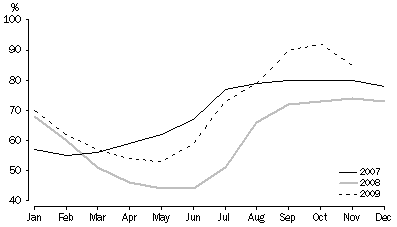 WATER
WATER
RAINFALL
According to the Bureau of Meteorology's Seasonal Climate Summary for South Australia, Spring 2009 was the wettest spring since 2005. When averaged across the South Australian agricultural areas as a whole, Spring 2009 has been the 25th driest since 1900.
Spring rainfall totals over South Australia were generally near average in the agricultual areas, tending above average across the pastoral areas. This was made up of generally above average rainfall in September, below average in October and generally well above average November rainfall after a dry first three weeks of the month.
Rainfall totals in the pastoral areas were very variable but generally ranging from 50 to 100mm. Erudina in the North East Pastoral district recorded 154.6mm as the highest reading in the pastoral districts. This was also the highest total spring rainfall recorded at this location since 1920. Totals in the agricultural areas were generally between 100 to 200mm, with totals widely exceeding 200mm about the Mount Lofty and Flinders Ranges, and several locations exceeding 300mm. Many of the western agricultural districts experienced totals in the 50 to 100mm range. Piccadilly in the Adelaide Hills recorded the highest rainfall total in the state this spring with 317.6mm.

Source
: 3-monthly rainfall anomalies for South Australia, Australian Bureau of Meteorology
RESERVOIR LEVELS
The Bureau of Meteorlogy reported that November 2009 was characterised by a very dry start (with record high temperatures) and was followed by above average rainfall across the Mount Lofty catchment areas. Reservoir storage levels fell to 85% of capacity as a result of increased consumption due to the extreme weather conditions. This is the first drop in capacity since May but is still well above storage capacities held at the same time in 2007 and 2008. Reservoir levels will be closely monitored during the next few months following the easing of Level 3 water restrictions and the introduction of simpler, more flexible watering times.
TOTAL RESERVOIR STORAGE, As a percentage of capacity, Adelaide

Source:
SA Water daily reservoir levels
 Print Page
Print Page
 Print All
Print All